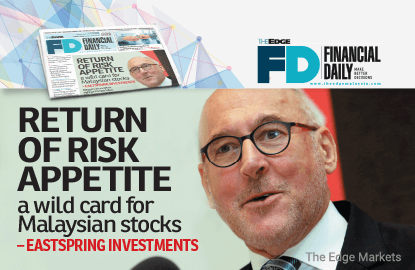
KUALA LUMPUR: The shift to risky assets seen in 2016 is set to accelerate this year, potentially lifting Malaysian stocks after three years of subdued performance that have made their valuations more attractive now, according to Eastspring Investments.
The asset management firm added that the US dollar strength in anticipation of US rate hikes seems well discounted, and US President Donald Trump’s penchant for policies that could worsen the US twin deficits suggests the US dollar is peaking.
During the market outlook 2017 briefing, Robert Rountree, global strategist of Eastspring Investments (Singapore) Ltd shared that the “yield hunt” has morphed into “yield with some risks”, then “yield with risk”, and eventually “risk”, pointing to the rise in demand for high-yielding bonds shifting to low-valued, high-dividend cyclical equities as an indication of rising risk appetite.
He added that investors are returning to long ignored markets and sectors such as cyclical sectors and emerging markets, especially as profit forecasts are rising and the spillover effect of the risk appetite could be a wild card for the Malaysian market.
Rountree also highlighted that fears over the stronger US dollar have hindered the Asian equities markets rally including Malaysia, especially if rising Asian corporate debt leads to another crisis similar to that seen in the Asian financial crisis. However, he said that the debt/equity ratio has remained relatively flat and is well below the crisis levels.
“The rise in Asian debt since 2008 has been mostly in local currencies with US dollar debt accounting for only 28% of total debt, while around 23% of Asian corporate sales are in US dollars,” he added.
Another point to note is that the strength of the US dollar has priced in the anticipated rate hikes in the US and could see a sharp reversal if Trump’s fiscal deficit expands to 6% of gross domestic product (GDP).
“If we put in the assumption that Trump is going to blow out the budget deficit to 6% of GDP we will start to look at [US] dollar weakness,” Rountree said.
The weakness in the US dollar indicates that a turnaround for the ringgit could be in sight.
“[The] ringgit looks like a very cheap currency and it all has to do with [a] confidence issue. It’s back to the Asian crisis low level based on the real effective exchange rate and confidence factors are behind it,” Rountree said.
Unlike other currencies that underperformed last year such as the rupiah and the Indian rupee, Malaysia does not have fundamental issues and has a current account surplus, he said.
He added that one key indicator to look for in the ringgit’s recovery is when the percentage of Malaysian exports to global exports sees an inflection point to a positive trend.
“When that happens, it would be the point of entry for the ringgit,” he added.
In line with Rountree’s view, Eastspring Investments Bhd chief investment officer Rudie Chan told the media that the FBM KLCI’s valuation looks attractive after a lacklustre performance for the past three years, but the market is expected to remain volatile until a return to the corporate earnings upcycle.
“Corporate earnings growth remains tepid but selective sectors relating to domestic consumption, infrastructure, commodities and exporters in general will do well,” Chan said.
In terms of valuation using both the price-earnings ratio (PER) and price-to-book (PB) ratio, the KLCI looks attractive as its PER has fallen below its five-year average level of 17 times while its PB fell sharply to near its five-year low level.
“Malaysia has always been a defensive market with huge domestic institution funds’ support, and that partly explains the relatively low market beta of 0.65 times. While 2017 is expected to continue to be volatile, we favour small- and mid-cap stocks as they are poised to benefit from the RM3 billion special fund announced during Budget 2017.
“Some of the thematic plays include the upcoming general election, stronger USD which will benefit exporters like plantation and selective income strategy,” Chan said
The withdrawal of the US from the Trans-Pacific Partnership (TPP) agreement will see the likelihood of the pact being scrapped, but Eastspring Investments believes that the impact would not be significant.
“The economic benefits have not been priced into the market, and it has been widely expected by the market for Trump to scrap the TPP. It doesn’t impact trade barriers too much either as it’s an agreement involving 12 countries and not Malaysia-US alone. The impact without [the] TPP is not as profound as what some people might think,” Chan said during a question-and-answer session.
He also said that while US trade still matters to Malaysia, there is a growing prominence of trades with Asia and China, while the economies in Asia including Malaysia tend to be domestic-driven.
On the ringgit’s recovery, Chan was more cautious as he noted that the local currency could continue to see pressure from US rate hikes, but agreed with Rountree that this has been priced in.
He also noted that the high foreign holding in Malaysian Government Securities could still pose a risk to the ringgit should there be a huge outflow. Chan, however cited that most of these foreign investors are long-term investors such as pension funds, which are likely to hold onto the asset.
“A sustainable rally in soft commodities together with Bank Negara Malaysia’s measures should help relieve the pressure on the currency,” he added.
Year to date, the KLCI has gained by 2.57% and advanced by 6.89% from a year ago, while the ringgit has seen a slight recovery of 1.05% to 4.439 against the greenback in 2017 after underperforming in 2016 and 2015. Recall that the ringgit was still trading at the 3.50 level less than two years ago and was flirting with the 3.00 level back in 2013 before the setback from the crude oil price collapse and the US dollar rally recently.